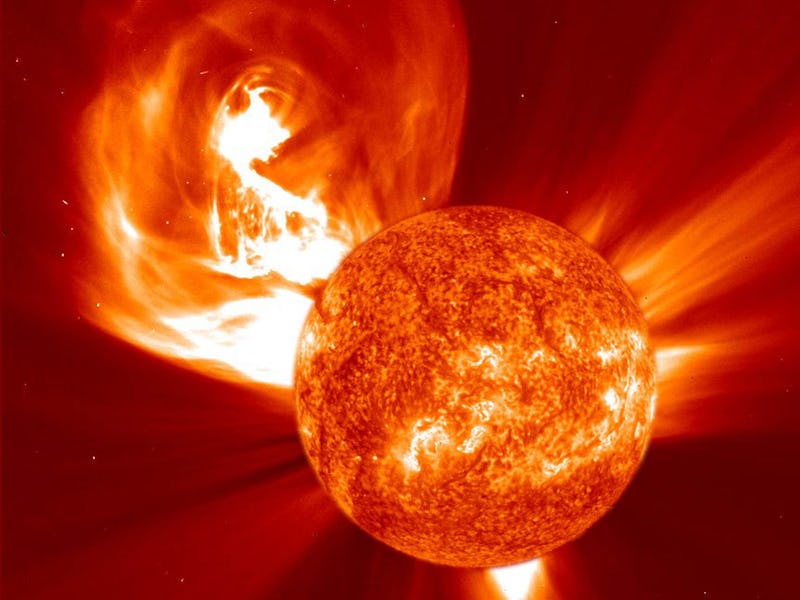NASA Is Revving Up Three Stellar Missions to Study the Sun
In two years (hopefully), we'll get a view of the sun like never before.

While Mars missions continue to captivate the minds of space geeks, NASA has plenty of other interesting projects, including the study of our sun — the most violent object in the solar system. On Monday, NASA’s Heliophysics Division (heliophysics is the study of the sun and how it interfaces with the ionosphere, heliosphere, and magnetosphere) had good news and bad news about three such missions.
The good news: two heliophysics missions, the Ionosphere Connection Explorer (ICON) and the Solar Probe Plus, are on track to hit all of their next milestones and be ready for launch in June 2017 and July 2018, respectively.
The bad news: the Solar Orbiter missions (a collaboration with the European Space Agency) has experienced a hiccup in its review of a key NASA-made instrument. Still, NASA officials say that delay should not affect that target launch window of October 2018.
Outside experts will spend Tuesday poring over NASA’s data and assessing the agency’s grip on its own timetables. While everyone hopes the deadlines are nailed, don’t be surprised if NASA needs to push back the launches in light of new information.
In the meantime, here’s the rundown of those aforementioned heliophysics missions, and why they will open up our view of the sun and its effects on our planet like never before.
The Ionosphere Connection Explorer
ICON will go into Earth’s orbit in June 2017 (and in the face of delays, no later than October of that same year). As the name suggests, ICON will study Earth’s ionosphere — the region of the upper atmosphere that is exposed to solar radiation and therefore becomes energetically charged. The ionosphere plays a critical role when it comes to propagating radio waves across large distances over the planet, which has implications in GPS and communications instruments.
The goal of ICON is to investigate in depth the relationship between the ionosphere and the rest of space. Specifically, this involves a careful observation of the “no man’s land” of the ionosphere, in which the atmosphere is blunted by solar winds and creates a very unpredictable environment. Four different instruments will observe the speed and temperatures of ionosphere particles, and gather data on ultraviolet light emitted or scattered by charged and neutral particles.
Solar Probe Plus
The most exciting mission on NASAs heliophysics docket is the groundbreaking Solar Probe Plus (SPP), which aims to send a spacecraft directly to the sun itself — specifically the outer corona. That will put the robotic probe within 3.67 million miles outside the sun’s surface still large distance, but incredibly closer than anything else we’ve ever launched towards the gargantuan ball of energy. (Consider that Earth is 93.96 million miles away from the sun, and Mercury, the closest planet, is still orbiting 35.98 million miles away.)
Artist's depiction of SPP nearing the sun.
The primary objective for Solar Probe Plus centers around solar winds — that amalgamation of super-charged particles around the sun that are ejected throughout the solar system. This study involves a closer point of view of the sun’s magnetic fields, coronal heat, and plasma — how those things contribute to the creation and ejection of solar winds.
To make this work, Solar Probe Plus needs to be fitted with the kind of shielding and hardware that can withstand the intensely harsh solar environment. At such a close range, the probe will be bludgeoned by energy about 520 times what Earth experiences. Needless to say, the close proximity to the sun will provide a supremely easy source of energy: NASA is fitting the probe with a dual system of photovoltaic arrays that should provide 343 watts at closest approach.
In addition, the probe should be reaching speeds of up to 432,000 mph — making it the fastest man-made object ever.
Solar Probe Plus is currently scheduled for a July 31, 2018 launch, aboard a Delta IV-Heavy rocket.
Solar Orbiter
Not to be completely outdone by NASA, the European Space Agency is building and launching the Solar Orbiter, which will actually get within an orbital distance of 26 million miles — not quite as close as the Solar Probe Plus, but still within Mercury’s own orbit. The goal behind the Solar Orbiter mission is to study in the inner heliosphere of the sun, and take a look at solar wind behavior, solar eruptions off the surface, and look closely at the polar regions of the sun.
Artist's depiction of the Solar Orbiter.
Best of all, the Solar Orbiter will be fitted with a string of high-resolution imagers that will give us the best pictures of the sun ever. Eat your heart out, Solar Dynamics Observatory.
NASA is contributing two instruments to the spacecraft (an imager, and an ion sensor for solar wind observations), as well as the launch vehicle and platform from Kennedy Space Center.
Unfortunately, the launch of the Solar Orbiter has already been pushed back from 2017 to October 2018. At the subcommittee meeting on Monday, NASA acknowledged that the scheduled review of the ion sensor had to be pushed by to 2017. Jennifer Kearns from the Science Mission Directorate emphasized that “this will not impact the [October 2017] launch date,” but it remains unclear if that’s for certain.
A previous version of this article incorrectly called ICON a “solar mission.” ICON is an ionosphere mission. Inverse regrets the error.